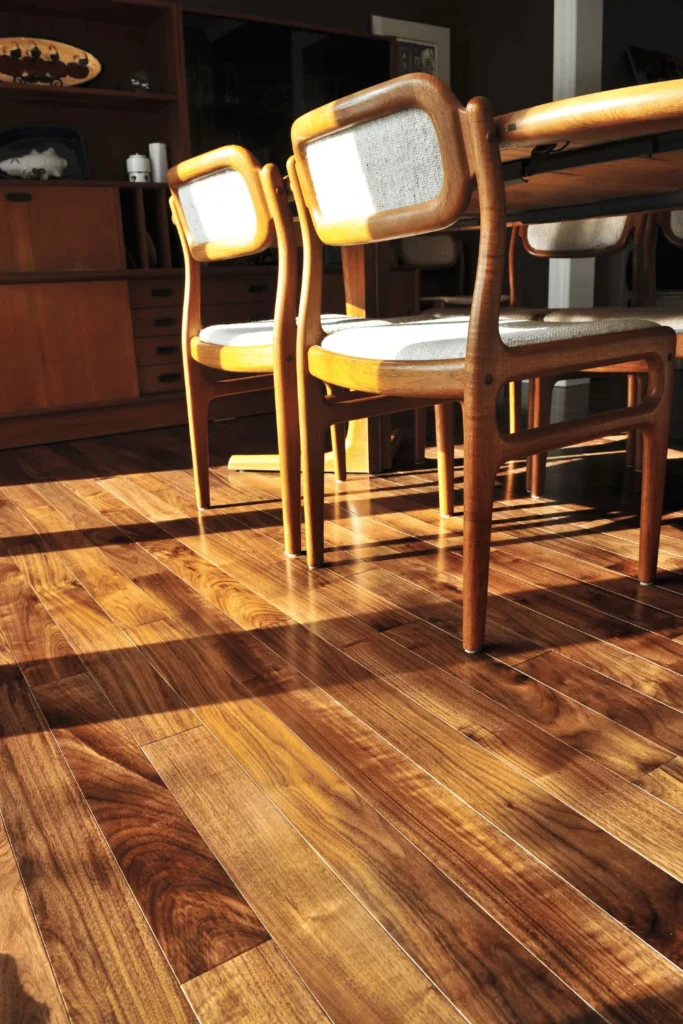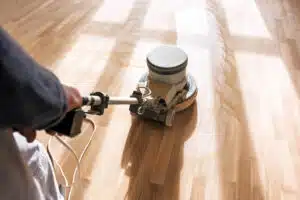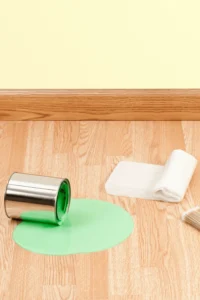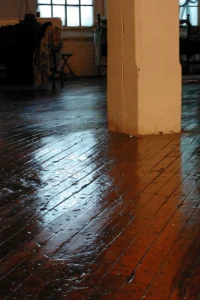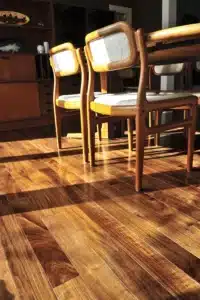Have you ever walked across a room and been greeted by an unexpected chorus of squeaks from your hardwood floors? If so, you’re not alone. Squeaky floors are a common issue in many homes, but have you ever stopped to ask yourself: “why do hardwood floors squeak?”
In order to get some hardwood floor squeak repair, your team will first need to pinpoint the problem so they can find the best solution possible for your home.
Understanding the Causes of Squeaky Hardwood Floors
One of the first steps to fix the squeak in the hardwood floor is identifying the root cause. Is it due to seasonal changes affecting the wood’s moisture content? Or is it a result of a more significant structural issue, such as a settling foundation or weakened joists?
Once you’ve determined the underlying cause, you can proceed with a targeted solution to silence the squeaks. In some cases, the fix may be as simple as adjusting the humidity levels in your home to stabilize the wood. In other instances, you may need to reinforce the floor’s structure or replace worn-out fasteners.
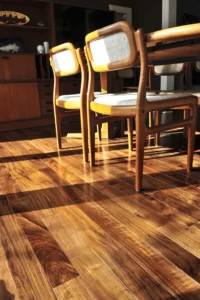
1. The Seasons Are Changing
So why do hardwood floors squeak? One of the most common reasons is that the seasons are changing.
A natural characteristic of hardwood floors is their response to changes in temperature and humidity. As the seasons change, so does the moisture content in the air, which directly impacts the wood. During warmer, more humid months, hardwood floors absorb moisture from the air, causing them to expand.
Conversely, in colder, drier months, the wood releases moisture and contracts. This expansion and contraction can lead to gaps between floorboards or cause them to press tightly against each other. Over time, this movement can loosen the nails or adhesive holding the boards in place, resulting in that familiar squeaking sound when pressure is applied.
To know how to fix hardwood floor squeaks, it’s essential to maintain a consistent indoor humidity level, typically between 30% and 50%.
Using humidifiers in the winter and dehumidifiers or air conditioners in the summer can help stabilize the moisture content in your home, reducing the likelihood of squeaky floors.
2. Joist Problems
The joists, which are the horizontal supporting beams beneath your floor, play a crucial role in the overall stability of your hardwood floors. Common issues with floor joists include warping, twisting, or spacing that is too wide, all of which can lead to a lack of support for the floorboards and, consequently, squeaks.
Over time, joists can also suffer from wear and tear or damage from moisture, pests, or other factors. Inspecting joists for signs of wear or damage is crucial in preventing and addressing squeaky floors. If you notice any issues, such as visible sagging or gaps between the joists and the subfloor, it’s essential to address them promptly.
In some cases, reinforcing the joists with additional support or replacing damaged sections may be necessary when figuring out how to stop hardwood floors from squeaking and ensuring the longevity of your hardwood floors.
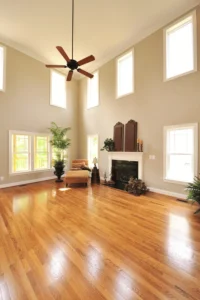
3. Subfloor Problems
The subfloor, which lies beneath your hardwood floors, provides a crucial foundation for the entire flooring system. Issues with the subfloor, such as unevenness, gaps, or deterioration, can cause hardwood floors to squeak. For example, if the subfloor is not level, it can lead to uneven pressure on the floorboards, causing them to move and squeak when walked on.
To prevent squeaks, it’s essential to ensure a stable and level subfloor during installation. If you’re experiencing squeaks in an existing floor, it may be necessary to inspect the subfloor for any signs of damage or unevenness. In some cases, adding shims between the joists and the subfloor or using a leveling compound can help stabilize the flooring and eliminate squeaks.
4. Tongue and Groove Issues
Hardwood floors are commonly constructed using a tongue and groove system, where each board has a protruding tongue that fits into a corresponding groove on the adjacent board. This design allows for a smooth, seamless surface and helps to hold the floorboards in place. However, improper installation or wear over time can lead to issues with this system, which can result in squeaking.
One common issue is when the tongue and groove are not properly aligned or fit together tightly during installation. This can leave room for movement, causing the boards to rub against each other and create noise. Additionally, over time, the tongue and groove can wear down, especially in high-traffic areas, leading to gaps and squeaks.
To ensure a quiet floor, it’s crucial to have proper alignment and a snug fit between the tongue and groove during installation. If you’re experiencing squeaks due to tongue and groove issues, it may be necessary to replace the affected boards or use wood glue to secure the loose connections.
How to Fix the Squeak in Hardwood Floors
Now that we’ve answered “why do hardwood floors squeak?” let’s figure out what practical solutions and techniques we can use for fixing them.
1. Locating the Source of the Squeak
The first step in fixing a squeaky floor is to identify the exact location of the squeak. You can do this by walking slowly over the floor and listening carefully to pinpoint the source.
You can also have someone walk on the floor while you listen from below if you have access to the underside of the floor. Marking the noisy spots with tape can help you keep track of the areas that need attention.
Once you’ve located the source of the squeak, it’s essential to determine the cause. Is it due to loose floorboards, issues with the subfloor, or problems with the joists? Identifying the underlying issue will guide you in choosing the most effective repair method.
2. Tightening Loose Boards with Screws
One effective way to eliminate squeaks in hardwood floors is by tightening loose floorboards with screws. This method secures the boards to the subfloor or joists, reducing movement and noise. To do this, locate the squeaky area and determine where the nearest joist is. Use a stud finder if necessary. Then, drill a pilot hole through the floorboard and into the joist, being careful not to drill too deep. Insert a trim-head screw into the hole and tighten it until the head is flush with the floor.
Be sure to choose the right type of screw for your flooring material and thickness. Screws with a low-profile head are ideal as they can be easily concealed with wood filler or a matching marker.
3. Using Shims to Stabilize Joists
If you find the squeak is due to a gap between the floorboards and the joists, using shims can be an effective solution. Shims are thin pieces of wood or plastic that can be inserted into the gap to reduce movement and stabilize the floor.
To install shims, gently tap them into the gap with a hammer until the squeak subsides. Be careful not to force the shim too tightly, as this could cause the floorboards to buckle. Trim any excess shim material flush with the joist. Proper shim placement is crucial for effective results, so ensure they are positioned correctly to provide adequate support.
We always recommend finding a hardwood floor professional, especially if you’ve never worked on hardwood flooring before. This will ensure you’re getting all the professional care and attention to your floors without the guesswork that comes along with DIYing a solution.
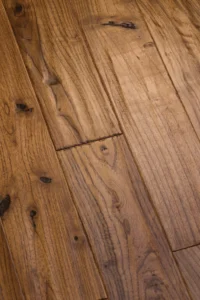
4. Applying Adhesive for Subfloor Issues
Another solution for squeaky floors is to apply adhesive to secure the subfloor and reduce movement. This method is particularly useful when the squeak is caused by a gap between the subfloor and the floorboards. To apply adhesive, first, locate the squeaky area and then use a caulking gun to inject construction adhesive into the gap. Apply pressure to the floorboards to ensure a tight bond. Allow the adhesive to dry completely before walking on the floor.
Selecting the right adhesive is important, so choose a product specifically designed for flooring applications and compatible with your floor and subfloor materials.
Bonus: Squeak-Reducing Solutions for Tongue and Groove Floors
For tongue and groove hardwood floors, addressing squeaks may require different approaches. One method is to apply a lubricant, such as powdered graphite or talcum powder, into the seams where the boards meet. This can reduce friction and noise when the boards rub against each other.
Alternatively, if the tongue and groove connection is loose, you can use wood glue to reinforce the joint. Apply a small amount of glue into the groove, then slide the tongue back into place and wipe away any excess. Use clamps or weights to hold the boards together until the glue dries. These solutions can effectively reduce squeaks in tongue and groove floors without the need for major repairs.
Preventive Measures to Avoid Future Squeaks
To ensure your hardwood floors remain silent and squeak-free, it’s crucial to take preventive measures. Regular maintenance and care can go a long way in preserving the integrity of your floors and preventing annoying noises.
1. Know Proper Installation Techniques
One of the best ways to prevent squeaky floors is to ensure they’re installed correctly from the start. We’re always happy to help alleviate any concerns you have about your existing hardwood floors (or help you install new ones!). Here are a few procedures we follow:
- Making sure the subfloor is level, clean, and dry before installing the hardwood.
- Using the appropriate underlayment to provide a solid foundation for the floorboards.
- Follow ingthe manufacturer’s guidelines for spacing and fastening the floorboards to prevent movement.
2. Maintaining Optimal Humidity Levels
Another critical factor in preventing hardwood floor squeaks is maintaining optimal humidity levels in your home. Wood is sensitive to changes in moisture, so keeping a stable indoor environment is essential. Here are some tips for you to follow as you maintain your hardwood floor:
- Aim to keep indoor humidity levels between 30% and 50%.
- Use a humidifier in the winter months when the air is dry to add moisture to the room.
- In the summer, use a dehumidifier or air conditioning to remove excess humidity.
- Avoid placing potted plants directly on the hardwood floors, as they can release moisture.
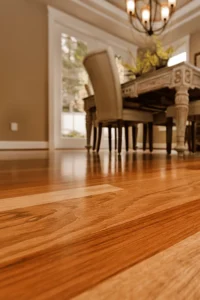
3. Having Regular Floor Inspections
To ensure the longevity of your hardwood floors and prevent squeaks, it’s important to conduct regular floor inspections. Catching and addressing issues early can save you time and money in the long run. During these inspections, look for signs of wear and tear, loose boards, gaps between the floorboards, and any changes in the level of the floor. Pay special attention to high-traffic areas, as these are more likely to develop problems.
For minor repairs, you may be able to fix them yourself. However, for more significant concerns or if you’re unsure how to proceed, definitely seek professional hardwood flooring experts!
Why Do Hardwood Floors Squeak? & Other Frequently Asked Questions
Why do my hardwood floors squeak?
Hardwood floors can squeak for various reasons, including changes in humidity, loose floorboards, issues with the subfloor or joists, and wear and tear over time. Identifying the specific cause is essential for finding the right solution to silence the squeaks.
Why do new hardwood floors squeak?
Even new hardwood floors can squeak if they weren’t installed correctly, if there are issues with the subfloor, or if the humidity levels in the home are not properly regulated. It’s important to address these issues early to prevent further damage and ensure a quiet floor.
TriArt Hardwood Floors – Your Squeaky Floor Solution in Atlanta, GA!
If you’re struggling with squeaky hardwood floors in Atlanta, GA, TriArt Hardwood Floors is here to help. Our team can diagnose the cause of your floor’s squeaks and provide effective solutions to restore peace and quiet to your home. Contact us today so we can help you enjoy beautiful, squeak-free floors!

